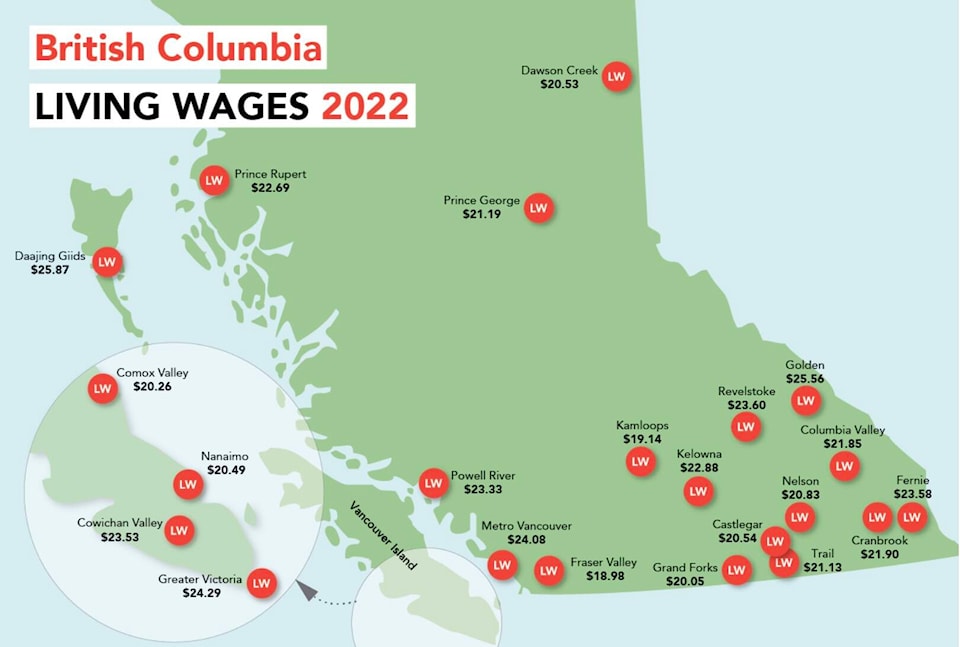Weekly grocery bills have skyrocketed this past year as has the cost of housing.
These and other highly inflated costs over the last 12 months directly affects the living wage calculation, which has gone up considerably in West Kootenay and Boundary towns, along with the rest of B.C.
The living wage is defined as a wage that is enough for a family with two young children to cover necessities, support the healthy development of their children, escape severe financial stress and participate in the social, civic and cultural lives of their communities.
It affords a decent but still very modest standard of living, without the extras many take for granted.
The Skills Centre, in Trail, says without question living wages have increased significantly over last year, as evidenced by a 2022 living wage report.
· In Trail, the new living wage calculation is $21.13 an hour for 2022, up 16 per cent over last year.
· In Castlegar, the living wage is $20.54 (this is Castlegar’s first year calculating a living wage)
· In Nelson, the living wage is now $20.83, up six per cent over last year.
· In Grand Forks, the 2022 living wage calculation is $20.05, a 17 per cent increase
Further, the Skills Centre points out that the increase is driven by two essentials that every family needs: food and shelter.
“Locally, we’ve all seen the cost increases and are finding our own ways to deal with them, regardless of our income,” says Heather Glenn-Dergousoff, poverty reduction program specialist at the Skills Centre in Trail, one of the region’s living wage employers. “For people in working poverty, the concept of a living wage is a huge step up financially that has ripple effects on their stress levels, their health and wellness, their job satisfaction, and their family life.”
A strikingly large gap exists between the 2022 living wages for communities across B.C. and the province’s minimum wage, currently $15.65 per hour.
“If you’re working a 40 hour week for minimum wage, you’re earning a little over $32,000 a year.,” Glenn-Dergousoff said.
A living wage for a 40 hour week is about $42,000 a year, she adds.
“That difference will be life-changing for a family.”
Other B.C. cities that have seen staggering living wage increases include: Kelowna at $22.88, 23.7 per cent higher than last year; Victoria at $24.29, 18.7 per cent higher than last year; and Metro Vancouver at $24.08, 17.3 per cent higher than last year.
“With general inflation shooting up to a 40-year high this year, and with the cost of food rising even faster and rent increasing everywhere, especially for families that need to move and are no longer protected by rent control, it’s not surprising to see such big increases this year,” says Anastasia French, Living Wage for Families provincial manager.
The price of groceries needed for a healthy diet for a family with two young children has spiked sharply this year, according to the latest B.C. food costing survey data. Food is the second-highest cost in most communities, only exceeded by the cost of housing.
Food used to be the third-most expensive item but is reported to have now edged ahead of child care costs after the B.C. government made major investments in child care affordability in 2018 that significantly reduced out-of-pocket child care costs for the living wage family.
“Until this year the living wage across most of B.C. remained below its 2018 peak because policy changes introduced by the B.C. provincial government significantly improved affordability for families with young children and offset increases in the cost of food, housing and other essentials,” says report lead author Iglika Ivanova, senior economist at CCPA-BC (Canadian Centre for Policy Alternatives).
“However, the savings generated by these policy changes, including significant child care investments and the elimination of MSP premiums, have now been effectively wiped out by ballooning rent and food costs.”
Although there are nearly 400 certified living wage employers across the province, Ivanova explains the labour market alone cannot solve all problems of poverty and social exclusion.
“Good public policy can make life more affordable for families and when government transfers don’t keep up with the rising cost of living, the families hardest hit are headed by already marginalized earners, including single mothers, Indigenous people and recent immigrants.”
Living wage employers include small businesses, non-profit organizations, unions and cooperatives. These employers have committed to pay all their direct staff and contract employees at minimum a living wage and to require their major service providers to also pay a living wage, including for janitorial, security and food service contracts.
Read more: Help wanted: Will the labour shortage impact Trail businesses?
Read more: Confidence is key to job training programs at Trail Skills Centre
newsroom@trailtimes.ca
Like us on Facebook and follow us on Twitter
The Skills Centre is a nonprofit that works toward strengthening rural and industrial communities and workplaces in B.C. through workforce skills development, training services, social development and poverty reduction programming. The centre offers skills training and wellness programs for youth, mature workers and equity deserving groups to build a caring community of skilled, productive and engaged people.
